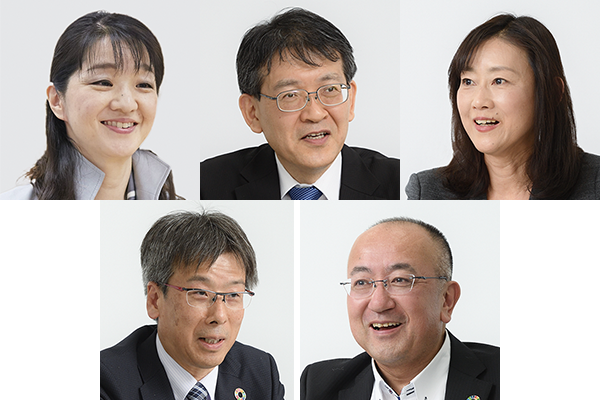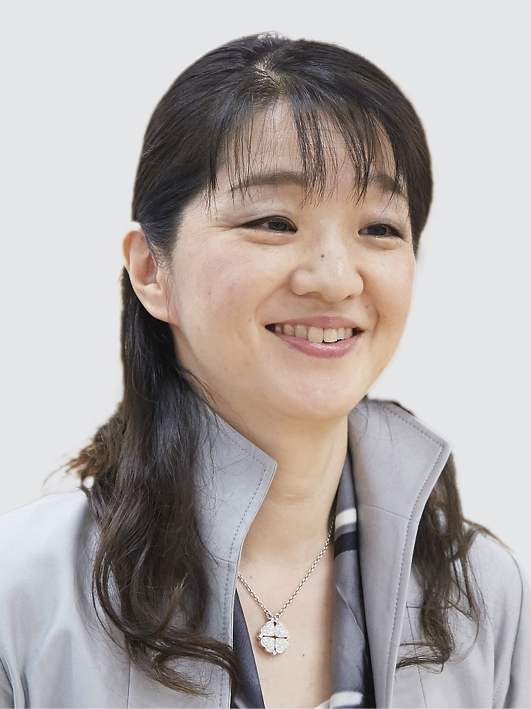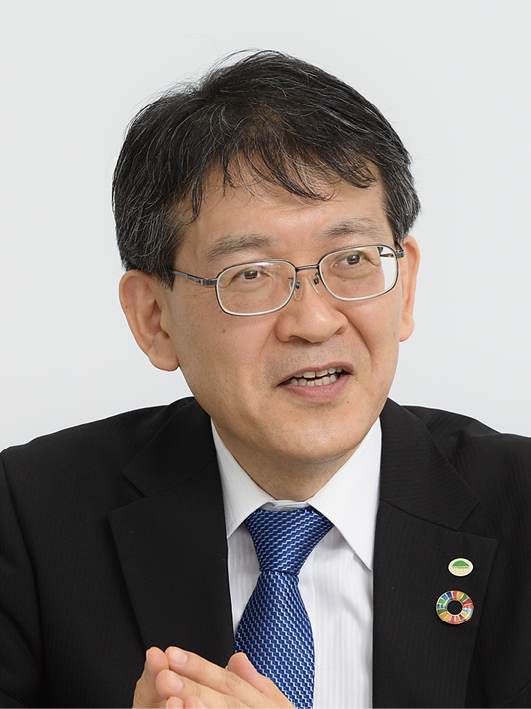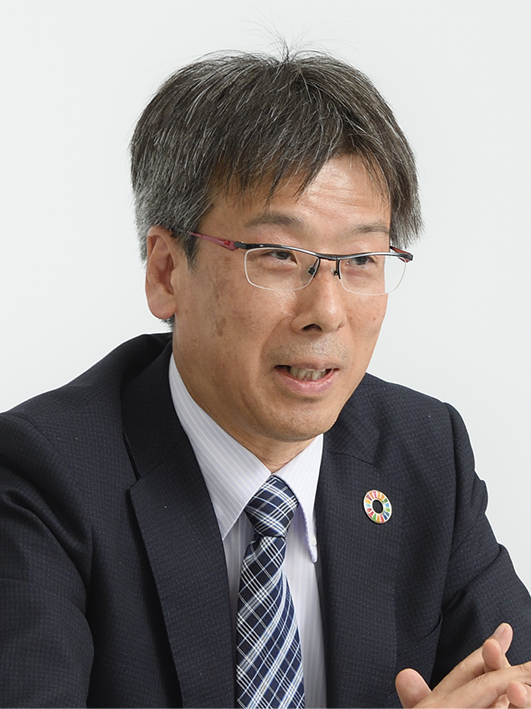COVER STORY:ActivitiesBecoming a “Digital and Clean” Factory Capable of Ongoing GrowthChallenges Facing New Naka-Marine Site in Pursuit of Decarbonization
Highlight
As climate change becomes ever more severe on a global scale, developed countries in particular have responded by stepping up their efforts to achieve carbon neutrality. Manufacturers, for their part, are being called upon to reduce the amount of CO2 emitted in manufacturing processes and elsewhere while also meeting demand for producing innovative products and services. Hitachi, meanwhile, has formulated its own Hitachi Environmental Innovation 2050 strategy that includes a target of achieving carbon neutrality at its business sites by FY2030. To this end, Hitachi High-Tech Corporation is utilizing its new Naka-Marine Site factory as a springboard for its efforts to decarbonize every step along the value chain. For this article, Hitachi Review spoke to five key people from within the Hitachi Group about what is happening with smart factories, now and in the future.

Growing Expectations for Companies to Decarbonize
 Megumu Tsuda
Megumu Tsuda
Deputy General Manager, Sustainability Promotion Division, Hitachi, Ltd.
Efforts to combat worsening climate change are spreading. These include setting the goal to “take urgent action to combat climate change and its impacts” among the Sustainable Development Goals (SDGs) adopted by a United Nations Summit in September 2015 and passing a resolution at the 26th UN Climate Change Conference of the Parties (COP26) held in Glasgow, UK in November 2021 to keep the rise in atmospheric temperature by 2030 to within 1.5°C relative to pre-industrial levels. Along with policy measures by national governments for achieving carbon neutrality by 2050, there are also rising expectations for voluntary action by the private sector.
Hitachi, too, is taking action to address environmental issues, including being the only Japanese company to be designated a Principal Partner for COP26. Megumu Tsuda, Deputy General Manager of the Sustainability Promotion Division at Hitachi, Ltd., gave a presentation at one of the conference seminars. She reported feeling a greater sense of urgency at COP26 than at other recent COPs, a recognition that “we do not have much time left.”
“Along with strong leadership from the UK hosts, I found it particularly significant that what had been stretch goals in the Paris Agreement were now being seen as realistic targets. In addition to needing to reduce our own carbon dioxide (CO2) emissions, which make up about 3% of the global total, Japan and Japanese corporations also need to think in terms of how we can contribute to actions against climate change taken by countries likely to experience further growth in the future. I noted that, among the booths at COP26, whereas many countries focused on things like policy measures, the Japan booth took a positive approach by also exhibiting technologies.”
Tsuda emphasized two particular aspects to the role that the private sector can play. One relates to how companies deliver meaningful value through their business operations and the other relates to how they can reduce the load these operations impose on the environment. On top of growing calls over recent years to disclose information on such matters, this put the focus on non-financial value rather than financial performance, with practices such as environmental, social, and governance (ESG) investing being seen as encouraging a positive cycle with respect to the environment.
Pursuing Sustainability from Diverse Viewpoints
 Youichi Nonaka
Youichi Nonaka
Distinguished Researcher, the Controls and Robotics Innovation Center, Research & Development Group, Hitachi, Ltd.
 Osamu Komuro
Osamu Komuro
Executive Officer, Hitachi High-Tech Corporation
 Naoko Takagi
Naoko Takagi
General Manager, Sustainability Management Department, CSR Division, Hitachi High-Tech Corporation
Under these circumstances, Hitachi has been actively engaged in achieving sustainability, including by accelerating what it is doing to reach carbon neutrality.
Hitachi’s Environmental Vision serves as a core framework for combining an improved quality of life with a sustainable society by resolving environmental challenges through a Social Innovation Business that engages in collaborative creation with stakeholders. Formulated on the basis of this vision, Hitachi Environmental Innovation 2050 lays out a practical roadmap for achieving a decarbonized society, a resource-efficient society, and a harmonized society with nature. As a pathway to a decarbonized society, the roadmap includes targets such as reducing CO2 emissions by 50% (compared to 2010) and achieving carbon neutrality at Hitachi’s business sites by FY2030, with carbon neutrality across the entire value chain to be achieved by FY2050.
As Tsuda explains, “It is vital that decarbonization is achieved with measures that work in tandem with a high level of circularity (a resource-efficient society). By doing so, I believe we can move closer to creating a harmonized society with nature. Given that our operations are global in scope, along with generating social and environmental value, Hitachi also needs to focus on collaborative creation with stakeholders while seeking to be a leader rather than a follower.”
For example, greater use is being made of electric power generated from renewable energy as one of the pathways to achieving carbon neutrality and this is an area where Hitachi is making solid progress, including at nine Hitachi business sites that were already obtaining 100% of their electricity from renewable sources in FY2020. Hitachi has also taken action to accelerate capital investment in CO2 emissions reduction. This has included the Hitachi internal carbon pricing (HICP) framework, which commenced operation in 2019, to incentivize the investment in factories and equipment needed to reduce emissions from Hitachi operations.
Hitachi’s efforts are not limited to within the group, but extend more widely. One example is the vision put forward by Hitachi-UTokyo Laboratory. Youichi Nonaka is a Distinguished Researcher at the Controls and Robotics Innovation Center, Research & Development Group, Hitachi, Ltd. who has been an active participant in work with the laboratory. Noting first the vision of achieving carbon neutrality by 2050, which is the target of the Japanese government, he also had the following to say on this subject.
“Hitachi-UTokyo Laboratory has been actively debating topics such as the roles that should be taken on by the government, private sector, and public sector, respectively, putting its conclusions together in the form of a statement on the pathways to reaching our desired destination. Regarding the path to one of these goals, there are a wide variety of problems that need to be addressed if Japan is to revitalize its economy and create a better society. Issues facing the energy sector include how best to generate the nation’s electric power, and who will pay for the cost of charging infrastructure as the shift to electric vehicles (EVs) accelerates. Solutions need to be found to these many and varied problems.”
Industry accounts for the second-highest proportion of Japan’s CO2 emissions after the energy (transformation) sector. As a manufacturing company, Hitachi is pursuing ambitious measures aimed at achieving carbon neutrality. In acknowledgment of this groupwide strategy, certain targets have been brought forward, with Hitachi High-Tech Corporation, a business that develops and manufactures measurement and testing equipment, now targeting the achievement of carbon neutrality in FY2027. As of 2022, the company has already achieved this goal at four of its sites. Osamu Komuro, Executive Officer at Hitachi High-Tech Corporation, explains the reasons why this was done.
“Our business mainly deals with the semiconductor and healthcare sectors. In particular, we have been experiencing growing demand from the semiconductor industry over the past few years for etching systems and metrology and inspection systems that play a vital role in objectives such as vehicle electrification, digital transformation (DX), and artificial intelligence (AI). Because manufacturers emit large amounts of CO2 in the production process, not only we, but also our customers have developed a strong interest in achieving carbon neutrality through initiatives such as logistics optimization and reducing power consumption.”
Naoko Takagi, General Manager of the Sustainability Management Department, CSR Division, Hitachi High-Tech Corporation, had the following to say on this subject.
“Hitachi High-Tech Group has been working on improvements to reduce the load on the environment over the more than 20 years since we gained accreditation under the ISO 14001 standard for environmental management systems. With global targets having been set in the Paris Agreement adopted at COP21 in 2015, we were inspired to set targets for CO2 emission reductions in gross rather than per-unit terms. Meanwhile, efforts undertaken under the Mid-term Environment Action Plan that ran up to 2018 focused on reducing CO2 through energy efficiency. While continuing to pursue this approach, we have now also proactively redirected our efforts toward adopting renewable energy in an effort to achieve zero CO2 emissions.”
Environmental Value of Smart Factories
 Yukihiro Yokoyama
Yukihiro Yokoyama
General Manager, Naka Production Engineering Department, Naka Manufacturing Division, Corporate Manufacturing Business Group, Hitachi High-Tech Corporation
The four Hitachi High-Tech sites that have achieved carbon neutrality are all factories, facilities that produce an order of magnitude more emissions than an office. In particular, there are certain factories where DX has been pursued with a view not only to boosting productivity through greater transparency, but also to making reforms across all business processes from design to production and maintenance. These are called smart factories and, in 2020, Hitachi’s Omika Works became the first Japanese factory to receive a Lighthouse* designation from the World Economic Forum in recognition of initiatives that include comprehensive optimization across the entire value chain.
As Nonaka put it, “The World Economic Forum has talked about how productivity improvements can lead to a better society. While DX is one of the keys to achieving this, it is acknowledged that less than 30% of the world’s factories have put this into practice. The Lighthouse project seeks to use such factories as models for DX and sustainability that others can use as a reference.”
Hitachi High-Tech’s new Naka-Marine Site factory is a prime example of such a smart factory that seeks to boost productivity through digitalization and to achieve carbon neutrality through system-wide optimization, with measures for achieving carbon neutrality built-in from initial construction. Supervision of this project was the responsibility of Yukihiro Yokoyama, General Manager of the Naka Production Engineering Department, Naka Manufacturing Division, Corporate Manufacturing Business Group, Hitachi High-Tech Corporation. He had the following to say about how the new factory came to be built.
“Our original plan was to build a production facility for critical dimension-scanning electron microscopes (CD-SEMs) on our Naka site. However, the production of these extremely precise instruments used for measuring the patterns formed on semiconductor and other wafers comes with very severe environmental requirements. Floor vibration in the part of the factory where instrument adjustment is performed, for example, must be kept to within 0.5 µm. There were those who felt that trying to meet such a requirement in a building of two or more floors was unrealistic, and we concluded that even if such a building could be constructed, maintaining the required production environment would prove impossible.”
This led to a revision of the initial plans from the end of 2017, resulting in the construction of the new Naka-Marine Site factory at an industrial park in the Hitachinaka district. With this change of location came a steady stream of ambitious ideas for how to go about construction, including switching the supply of electricity to the new factory to renewable hydroelectric power.
- *
- A designation for advanced smart factories that are leading the Fourth Industrial Revolution.
Naka-Marine Site’s Pursuit of “Digital and Clean” Operation
“Digital and Clean” was selected as Naka-Marine Site’s conceptual theme. As the growing sophistication of the instruments being produced is bringing many new challenges for a manufacturing site that in the past has relied on a mix of people and technology, digitalization has been used first of all as a means of minimizing quality variability. A wide variety of measures have been adopted, including the establishment of a work monitoring system and the development and deployment of an integrated management system that extends from the analysis and visualization of product-related data to the provision of feedback to production.
As Yokoyama explained, “For the digitalization of utilities, we focused in particular on the air conditioning that is crucial for maintaining a clean environment. We went about design and development on the basis of work on visualization and analysis that looked at how factors such as temperature, humidity, and particulates influence production conditions, treating the presence or absence of defects as part of the manufacturing process conditions rather than as something that can be left to the factory to manage.”
Reducing the emission of CO2 from the manufacturing process requires the lowering of power consumption and recognizing that the key to achieving this lies in how to go about producing high-quality, defect-free products quickly and efficiently. While digitalization delivers considerable benefits for production management, rather than limiting themselves to this area, the Naka-Marine Site factory sought to gain additional benefits by extending the scope of digitalization to also cover utilities.
The second objective of being “clean” encompasses the two separate areas of clean production practices and environmentally conscious clean energy. As a clean production environment is an essential requirement for producing precision instruments like CD-SEMs, automation and labor-saving practices are utilized to reduce the micro-sized contaminants produced by manual activities. Use of automatic guided vehicles (AGVs) on the assembly line means that human workers can focus on high-value-added tasks such as assembly, leaving the materials handling work to the machines. Assembly work that in the past was performed by two workers working together under the instrument can now be performed safely by a single worker using an assembly assistance system. On the adjustment line, the task of delivering a wafer to the instrument and replacing the previous wafer has been fully automated thanks to the development of a collaborative robot integrated into an AGV. They have also created a smart production line that keeps intervention by human workers to the barest minimum, including by putting smart systems in place that allow adjustment work to be performed remotely from outside the clean room, thereby reducing the number of workers and shortening lead times. Meanwhile, 24-hour monitoring by particle sensors installed at 90 different locations ensures that cleanliness is maintained, while power consumption has been reduced to one-eighth of the previous level through the use of newly installed plasma cleaning equipment that significantly shortens the degassing time.
Figure 2 | Staff and AGV at Work in Clean Room (Left) and Remote-control Room (Right)
In addition to using power from a hydro power plant, clean energy is also obtained from photovoltaic panels installed on the roof of the building with the capacity to generate 1,000 MW of electricity annually.
Komuro commented that, “The installation of photovoltaic panels was about more than just the adoption of renewable energy, it was also motivated by our desire to produce our own energy. While the panels only supply about 5% of the factory’s annual electricity requirements, we also intended it to demonstrate to all staff just how difficult carbon neutrality will be to achieve. This was also why we chose to put up a monitor showing how much power is being generated at any given time. In the future, we intend to augment our sensing to a level where we can show the energy consumption for each floor and our hope is that this will help us achieve further energy efficiency.”
Whereas design, production engineering, and manufacturing are separated from one another at many factories, the engineering and manufacturing sites are brought closer together at the Naka-Marine Site factory through the consolidation of data.
Figure 3 | Photovoltaic Panels Installed on Factory Roof (Left) and Indoor Monitor Showing Level of Electricity Generation (Right)
Expanding “Connectedness” through the Value Chain
Having only just commenced operation, what sort of smart factory can the Naka-Marine Site factory expect to become in the future? Tsuda points to how the nature of Hitachi High-Tech’s business and this new factory share an affinity with circularity and greener practices.
“Along with calling for carbon neutrality at Hitachi factories, we have also had occasion to advocate for the greening of their manufacturing processes and businesses and for the importance of a circular economy. To advance these causes, it is vital that we correctly measure, visualize, and analyze what is happening and make improvements to address the problems this uncovers. I also believe that this process of accurate measurement and analysis will help find solutions to challenges facing the world as a whole. In the sense that people’s productivity is directly linked to things like motivation and a sense of purpose, I also believe that the Naka-Marine Site factory is packed with great possibilities.”
Komuro also commented, saying, “I see the opening of smart factories as only the beginning. There remains much more to do, including utilizing digital technology to perform analyses that merge data from the production process itself with data from the cleaning and processing equipment used in production. By using this to provide feedback to design and production, we see it as a way to enhance the reliability of production processes, to make improvements to future equipment, and to develop new products. While reducing the emission of CO2 from the production process is an important part of achieving carbon neutrality, enhancing the performance of the products produced is likewise essential. We also need to expand beyond our own in-house efforts to encompass suppliers and to tie them in with the wider value chain. While this work will not be completed any time soon, through incremental improvements, I hope that we can turn this new factory into a smart factory capable of ongoing growth.”
Yokoyama added that, “I hope we can continue to grow on the basis of being both ‘digital and clean.’ It is fair to say that more than half of the job of making things at a factory happens off-site, namely at suppliers’ sites. This makes working with our suppliers very important. The use of digital technology to link our operations together allows the procurement of parts to run smoothly. Likewise with quality data, if we can successfully match this up with our production data then we can look forward to further improvements in quality and reliability. We are currently working on initiatives that will expand practices like these beyond Naka-Marine Site to also encompass our suppliers.”
Takagi commented that, “It is vital that all staff recognize their own responsibilities for taking action on the environment and that this is something to be addressed in the course of their work. Together with materials recycling and reducing CO2 emissions across the value chain, this is something that all departments need to get on board with, including sales, design, procurement, manufacturing, and maintenance and support. Through media such as websites and internal newsletters, we are also looking to tell people both inside and outside the company about all the different things we are doing to address environmental issues, both at Naka-Marine Site and elsewhere.”
Nonaka commented that, “At the Research & Development Group where I work, in addition to telling the world about this concept of factories that grow, like Naka-Marine Site and Omika Works, we are also working to establish international standards for these practices through organizations such as the International Organization for Standardization (ISO) and the International Electrotechnical Commission (IEC). When you look at the Hitachi value chain as a whole, CO2 emissions that occur in the use of products make up the largest proportion of total emissions. While smart factory initiatives represent a first step toward carbon neutrality, it is essential that we not only reduce CO2 emissions from Hitachi factories, but also accelerate work on creating an inclusive society by sharing data with customers, suppliers, and others. On energy, we will share value as we engage in collaborative creation with various local government agencies. We hope to expand the idea to our customers and suppliers that sustainability is about adopting such an extreme stance.”
Based on the concept of being “Digital and Clean,” Hitachi High-Tech’s Naka-Marine Site is pioneering the future of manufacturing across the entire value chain. As it drives action on the environment not just at Hitachi High-Tech, but also across the Hitachi Group, through the supply of products and in the form these factories take, this idea of smart factories capable of ongoing growth is showing what a sustainable society will look like.




